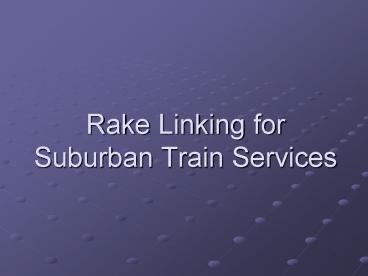Rake Linking for Suburban Train Services PowerPoint PPT Presentation
1 / 27
Title: Rake Linking for Suburban Train Services
1
Rake Linking for Suburban Train Services
2
Rake-Linker
- The Rake-Linker assigns physical trains (rakes)
to services that have been proposed in a
timetable - Services will be linked directly at terminals or
indirectly by proposing new services between
terminals - New services can then be run as empty movements
or as additional commercial services
3
Typical use of the rake linker
- Step 1 Find the minimum number of rakes required
to run all the services - Step 2 Minimize the number of new services
(including empty rake movements), with the same
number of rakes as in Step 1 - Step 3 Minimize the number of rakes and
proposed/empty rake movements further by
perturbation and sensitivity analysis. - Step 4 Check the constraints on stations and
line segments for the feasibility and allot
platforms to rakes at each station.
4
Modeling
- Construction of service graph
- Vertices services
- Edges possible direct and indirect successors to
each node - Rake Cycle construction
- Stated as minimum chain decomposition problem
- Step 3 Min Cost Flow formulation
- Modification of service graph
- Each node is spilt into two nodes
- 4 dummy source and 4 dummy sinks
- Allocation of suitable capacities, lower bounds
and costs to all the edges in the network
5
Direct and Indirect Edges
- Direct edges corresponds to linking of a service
at one terminus to other services at the same
terminus maintaining car-shed/ stabling/turn-aroun
d constraints - Indirect edges corresponds to linking of a
service at one terminus to other services at a
different terminus by proposing an empty rake
movement between them and maintaining
car-shed/stabling/turn-around constraints at both
the stations
6
MCF Network
Self edge
9car source
9Car sink
Dummy source
Dummy Sink
Super source
Super Sink
12Car Sink
12Car source
Unused rake edge
7
The overall system view
SCHEDULER
Inputs Set Of Constraints
Utilities
TIME TABLE OR PARTIAL TIME TABLE
RAKE-LINKER
8
Features of the Rake Linker
- Finds rake links for various scenarios
- (by changing parameter values)
- Outputs the minimum no. of rakes and minimum no.
of empty rake movements - Gives output suitable for viewing individual
rake-links and rake-cycles as well as the
timetable format - Gives stable table, occupancy table and charts
for every terminus
9
Features (contd.)
- Can also link the rakes in FIFO fashion at every
terminus - Consideration of different types of rakes during
assignment e.g., 9 Car, 12 Car - AC rakes, AC-DC rakes
10
Inputs for Rake Linker
- Partial Time Table (obtained from scheduler)
- Station Table
- Inter Terminal Transit Time Matrix
- Parameter Table
11
Partial Time Table
- The rake linker uses
- Terminal locations and start and end timings for
each service - Service attributes such as rake type of the
service (e.g. 9 Car/12 Car) - Any rake links that must be maintained
12
Partial Time Table
13
Hold Resource (Station) Table
14
Inter Terminal Transit Time Matrix
15
Parameter Table
16
Outputs of the Rake Linker
- Partial time table (Modified) updated RakeLinkId
and Distance - RakeTable (detailed rake cycles)
- RakeServTable (short form of Rake Table)
- Stable Table (stabling requirements)
- Occupancy Table (platform requirements)
- Platform Occupancy Chart (visual scenario)
17
Partial time table (Modified)
18
Rake Table
19
Platform Allocation
- Problem Given platform preferences, allocate a
platform to each service. - Algorithm
- Start with all platforms as empty.
- In increasing order of time, if a train arrives
or departs, generate new possible allocations. - Repeat till all the train arrival and departure
complete. - Trace the path back to root to get a possible
allotment of platforms
20
Platform Allocation
- Three platforms at a Hold Resource.
- Order of events
- arrival of service 1
- arrival of service 2
- departure of service 1
- Platform preferences of train 1, 2 1,2,3
- Initially all platforms empty
21
Platform Allocation
22
Platform Occupancy Chart
Rake Linker
generates
Platform Occupancy Table with Platform Preferences
After Checking Feasibility at all Stations
Generates final Occupancy table With assigned
Platform number
Platform Occupancy Chart
generates
23
Platform Occupancy Chart
24
Perturbation and Sensitivity analysis of Rake
Linker
- Computes the change in the rake linking objective
(minimum no. of rakes, minimum no. of empty rake
movements) for small changes in operating
parameters (turn-around time, run time,
prepone/postpone) - Modeling
- Residual network additional edges
- Finds negative cost cycles
- Saturates negative cost cycles
- Outputs new Rake Table
25
Perturbation and Sensitivity analysis (contd.)
- Examples
- At Vasai Road (BSR) in WR, if we permit
turn-around time of one service from 10 mins to 9
mins, we can save a rake - At Bandra (BA), if we permit turn-around time of
two services from 6 mins to 5 mins, we can save
one empty-rake movement - Savings are also possible with perturbing either
run-times or preponing/postponing the timings of
a few services
26
Applications and Examples
- Validated on full scale Western Railway Mumbai
Suburban network - Outputs 62 rakes and 10 empty movements for 963
services - WR uses 64 rakes (22 are 12 Car rakes) and 70
empty rake movements - Useful application
- During maintenance block time
- To check optimality
27
FIFO Rake Linker
- It assigns rakes to each service in First-In
First-Out fashion at every terminus - Features
- outputs a detailed rake table in Time table
format - Run time (3 secs for number of rakes, 10 secs for
rake table) - Used for analyzing and comparing rake links with
those generated by MCF-solver

